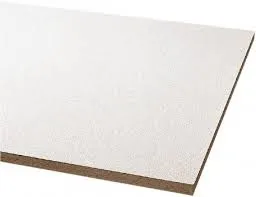Nov . 28, 2024 00:50 Back to list
Main Ceiling Grid Design and Installation Techniques for Modern Interiors
Understanding Main T Ceiling Grid An Essential Element in Modern Architecture
In the realm of architecture and interior design, certain elements are fundamental to both aesthetic appeal and structural integrity. One such component is the main T ceiling grid, a crucial system that supports ceiling tiles while ensuring a seamless and visually appealing look. As we delve into the details of main T ceiling grids, we will explore their benefits, applications, and the installation process that has made them an indispensable part of modern building practices.
What is a Main T Ceiling Grid?
A main T ceiling grid is a framework used in suspended ceiling systems. Comprising T-shaped metal components, this grid creates a grid-like structure to which ceiling tiles are attached. The main T refers to the primary support members that run perpendicular to the ceiling joists, with cross tees connecting to form a comprehensive grid. This design not only allows for easy installation of ceiling tiles but also supports lighting fixtures, HVAC systems, and other installations requiring access to the ceiling space.
Benefits of Using a Main T Ceiling Grid
1. Aesthetic Flexibility Main T ceiling grids provide an attractive finish to any room. With a variety of ceiling tile designs available—from acoustic panels to decorative tiles—designers can create tailored aesthetics that suit the specific atmosphere of a space.
2. Acoustic Management Many ceiling tiles used in conjunction with a main T grid are designed to help absorb sound. This characteristic is particularly beneficial in offices, schools, and other public spaces where noise reduction is essential for maintaining an effective working or learning environment.
3. Easy Access One of the primary advantages of a suspended ceiling system using a main T grid is the access it provides to the plenum space above it. This space can house electrical wiring, plumbing, and HVAC ducts, allowing for easy maintenance and modifications without disrupting the ceiling itself.
4. Cost-Efficiency The installation of a main T ceiling grid and associated tiles can be more affordable than other ceiling options. The components are usually lightweight and easy to handle, which reduces labor costs during installation.
5. Hiding Imperfections A suspended ceiling can effectively conceal unsightly wires, pipes, and structural elements that may detract from the overall look of a space. This ability to camouflage imperfections makes main T ceiling grids a popular choice for both new constructions and renovations.
Applications in Various Settings
Main T ceiling grids are versatile and can be used in a wide range of settings.
main t ceiling grid

- Commercial Spaces In offices, retail stores, and other commercial environments, these ceiling systems support lighting and HVAC needs while enhancing visual appeal. - Educational Institutions Schools and universities rely on main T grids to provide a conducive learning environment. Acoustic tiles can minimize noise between classrooms, fostering a better educational atmosphere.
- Healthcare Facilities Hospitals and clinics benefit from main T ceiling grids, where hygiene and functionality are paramount. The system allows easy access to utilities for maintenance without compromising cleanliness.
- Residential Applications homeowners increasingly opt for suspended ceilings in basements and living rooms
. Their ability to create different ceiling heights and stylish options contributes to modern interior design.The Installation Process
Installing a main T ceiling grid is a structured process that can typically be completed within a day by professionals or skilled DIYers.
1. Planning The first step involves careful planning, where measurements are taken, and the layout of the grid is determined based on the room dimensions.
2. Marking Next, the ceiling is marked to indicate where the main T and cross tees will be positioned.
3. Mounting the Main T’s The main runners are then installed, attached to the wall through clips or screws.
4. Installing Cross Tees Cross tees are fitted into the main runners, effectively forming the grid pattern.
5. Placing Ceiling Tiles Finally, the ceiling tiles are installed within this grid, completing the look.
Conclusion
The main T ceiling grid is more than just a practical construction component; it is a foundational feature that enhances the functionality and aesthetics of modern spaces. Whether in commercial, educational, or residential settings, understanding its benefits, applications, and installation process can help both professionals and homeowners make informed decisions about their ceiling systems. As architectural trends continue to evolve, the main T ceiling grid will undoubtedly remain a staple in creating versatile and appealing environments.
-
Durable Ceiling T Grid Systems | Easy InstallationNewsAug.29,2025
-
PVC Gypsum Ceiling: Durable, Laminated Tiles for Modern SpacesNewsAug.28,2025
-
Pvc Gypsum Ceiling Is DurableNewsAug.21,2025
-
Mineral Fiber Board Is DurableNewsAug.21,2025
-
Ceiling Tile Clip Reusable DesignNewsAug.21,2025
-
Ceiling T Grid Modular DesignNewsAug.21,2025







